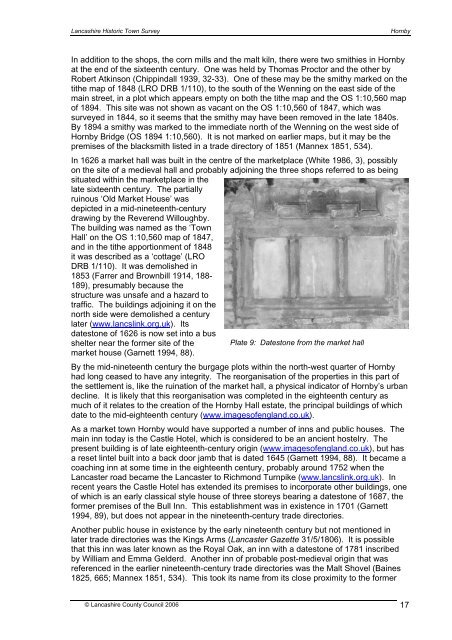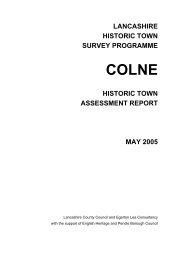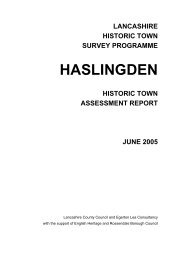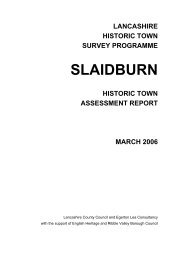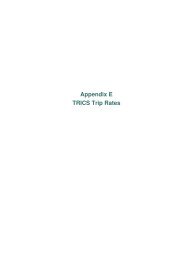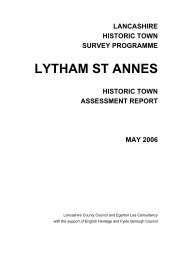HORNBY - Lancashire County Council
HORNBY - Lancashire County Council
HORNBY - Lancashire County Council
Create successful ePaper yourself
Turn your PDF publications into a flip-book with our unique Google optimized e-Paper software.
<strong>Lancashire</strong> Historic Town SurveyHornbyIn addition to the shops, the corn mills and the malt kiln, there were two smithies in Hornbyat the end of the sixteenth century. One was held by Thomas Proctor and the other byRobert Atkinson (Chippindall 1939, 32-33). One of these may be the smithy marked on thetithe map of 1848 (LRO DRB 1/110), to the south of the Wenning on the east side of themain street, in a plot which appears empty on both the tithe map and the OS 1:10,560 mapof 1894. This site was not shown as vacant on the OS 1:10,560 of 1847, which wassurveyed in 1844, so it seems that the smithy may have been removed in the late 1840s.By 1894 a smithy was marked to the immediate north of the Wenning on the west side ofHornby Bridge (OS 1894 1:10,560). It is not marked on earlier maps, but it may be thepremises of the blacksmith listed in a trade directory of 1851 (Mannex 1851, 534).In 1626 a market hall was built in the centre of the marketplace (White 1986, 3), possiblyon the site of a medieval hall and probably adjoining the three shops referred to as beingsituated within the marketplace in thelate sixteenth century. The partiallyruinous ‘Old Market House’ wasdepicted in a mid-nineteenth-centurydrawing by the Reverend Willoughby.The building was named as the ‘TownHall’ on the OS 1:10,560 map of 1847,and in the tithe apportionment of 1848it was described as a ‘cottage’ (LRODRB 1/110). It was demolished in1853 (Farrer and Brownbill 1914, 188-189), presumably because thestructure was unsafe and a hazard totraffic. The buildings adjoining it on thenorth side were demolished a centurylater (www.lancslink.org.uk). Itsdatestone of 1626 is now set into a busshelter near the former site of the Plate 9: Datestone from the market hallmarket house (Garnett 1994, 88).By the mid-nineteenth century the burgage plots within the north-west quarter of Hornbyhad long ceased to have any integrity. The reorganisation of the properties in this part ofthe settlement is, like the ruination of the market hall, a physical indicator of Hornby’s urbandecline. It is likely that this reorganisation was completed in the eighteenth century asmuch of it relates to the creation of the Hornby Hall estate, the principal buildings of whichdate to the mid-eighteenth century (www.imagesofengland.co.uk).As a market town Hornby would have supported a number of inns and public houses. Themain inn today is the Castle Hotel, which is considered to be an ancient hostelry. Thepresent building is of late eighteenth-century origin (www.imagesofengland.co.uk), but hasa reset lintel built into a back door jamb that is dated 1645 (Garnett 1994, 88). It became acoaching inn at some time in the eighteenth century, probably around 1752 when theLancaster road became the Lancaster to Richmond Turnpike (www.lancslink.org.uk). Inrecent years the Castle Hotel has extended its premises to incorporate other buildings, oneof which is an early classical style house of three storeys bearing a datestone of 1687, theformer premises of the Bull Inn. This establishment was in existence in 1701 (Garnett1994, 89), but does not appear in the nineteenth-century trade directories.Another public house in existence by the early nineteenth century but not mentioned inlater trade directories was the Kings Arms (Lancaster Gazette 31/5/1806). It is possiblethat this inn was later known as the Royal Oak, an inn with a datestone of 1781 inscribedby William and Emma Gelderd. Another inn of probable post-medieval origin that wasreferenced in the earlier nineteenth-century trade directories was the Malt Shovel (Baines1825, 665; Mannex 1851, 534). This took its name from its close proximity to the former© <strong>Lancashire</strong> <strong>County</strong> <strong>Council</strong> 2006 17


